Folk art
Folk Art: Themes from Village Life
In most pottery-making families, children are encouraged to play with clay, making forms, scratching and painting designs, even putting their pieces in the fire. All kinds of shapes, forms, figures and creatures emerge from the flames. In some villages, those same children grow up to become figure-makers who portray aspects of the village life around them. Ubiquitous figures include chickens, coyotes, turtles, horses, bears, turkeys and fish.
In some pueblos, human likenesses on pottery are banned. In others, almost anything goes. In some, that dividing line is between indigenous religion and Christianity, while in others, those are somewhat merged.
The storyteller figure is a special figure from "village life." The way the ancient oral histories were passed down through the generations were through grandparents singing them to their grandchildren in the ancient tongues. It's hard to image a Hopi potter making storytellers but there are some Hopi potters who carve, etch and paint human (usually wearing katsina masks) on their pieces. Some of those designs are set against village backgrounds. There have been a couple Hopi potters who made figurines of katsinas (in that world, when one puts on the clothing and dons the mask, one becomes the katsina).
Only Christian Dineh potters picture forms other than yeibichai (or their costumed representatives) on their pieces. Elizabeth Manygoats has a whole series of Lifestyle pots inspired by scenes from the day-to-day life around her. She also makes human and animal figures. A favorite has been her figures of women dressed up and taking selfies... Her husband, Jonathan Chee, also makes Navajo Folk Art figures, except he incorporates a lot of motor vehicles in his work, too.
Among the Rio Grande pueblos, the potters of Santa Clara, San Ildefonso, Jemez, Zia and Cochiti picture human forms in some of their designs. Generally, those humans are pictured participating in one or another ceremony on the pueblo and are dressed in the appropriate garments (and makeup) for the ceremony, except at Cochiti.
Cochiti has a long history of making figurative pottery and while that was paused during the long occupation by the Spanish, it has only expanded since the railroad first reached the pueblo. The storyteller figure was first innovated at Cochiti and potters there have since add multiple variations to that basic theme. They have also made deer, antelope, bear, horse and other storyteller figures, along with Corn Maidens, Singing Angels, mermaids, opera singers, koshares and two-headed circus ringmasters.
Similarly to Cochiti, Jemez potters make lots of various-creatured storytellers but they also paint, carve and etch images of various pueblo dancers in full costumes with masks. Some Jemez potters have become famous for their koshare figures.
Since the popularity of sgraffito designs exploded, there has been an equally great expansion in appropriately dressed eagle, deer, antelope, bear and other clan dancer designs.
Showing all 7 results
-
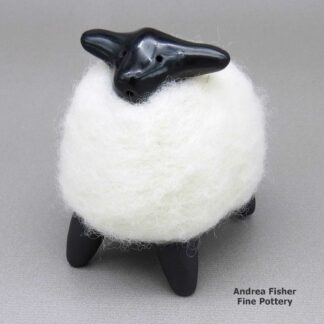
Joe and Eunice Naranjo, zzsc3a067m1, Black sheep figure with white wool body
$150.00 Add to cart -

Joe and Eunice Naranjo, zzsc3a067m2, Black sheep figure with white wool body
$150.00 Add to cart -
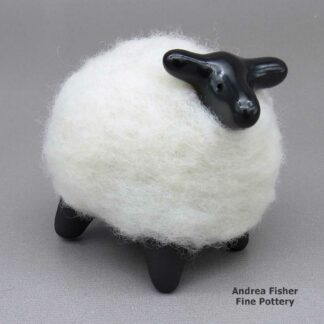
Joe and Eunice Naranjo, zzsc3a067m3, Black sheep figure with white wool body
$150.00 Add to cart -
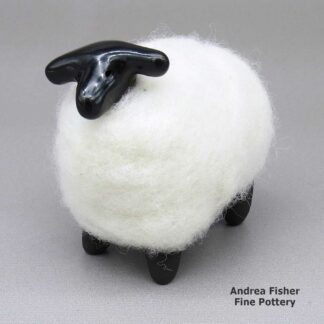
Joe and Eunice Naranjo, zzsc3a067m4, Black sheep figure with white wool body
$150.00 Add to cart -
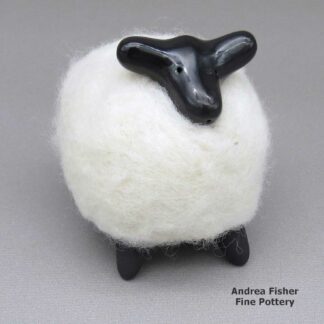
Joe and Eunice Naranjo, zzsc3a067m5, Black sheep figure with white wool body
$150.00 Add to cart -
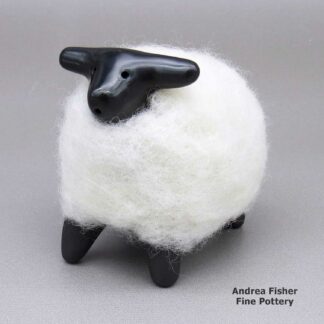
Joe and Eunice Naranjo, zzsc3a067m6, Black sheep figure with white wool body
$150.00 Add to cart -
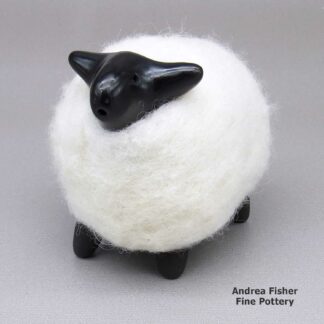
Joe and Eunice Naranjo, zzsc3a068, Black sheep figure with white wool body
$175.00 Add to cart
Showing all 7 results